Search the Special Collections and Archives Portal
Search Results
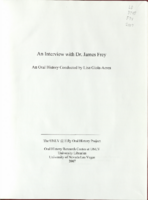
Transcript of interview with Dr. James Frey by Lisa Gioia-Acres, February 14, 2007
Date
2007-02-14
Archival Collection
Description
James Frey was born in Eureka, South Dakota, in 1941. His father worked in creamery and his mother was a registered nurse. When James was nine, the family,including his twin sister, relocated in Sioux Falls where his dad was plant manager for a dairy. He joined the YMCA in the fourth grade and ended up working for them until James attended Augustana College in Sioux Falls, graduating with a major in sociology and a minor in history. After graduation, he worked for three years at the YMCA in Sioux Falls as program director. He earned his master's degree in sociology at the University of Iowa in two years, and was hired at the YMCA in Whittier, California, where he worked for three years. While working in Whittier, James was offered a fellowship to Washington State University in Pullman. He committed to completing his doctorate in three years, and while still working on his dissertation began sending out applications. He sent one to UNLV and arrived in Las Vegas for an interview in 1974. James was hired as assistant professor of sociology at UNLV, and immediately established a survey center at the university. He also converted his dissertation into a book length manuscript and had it published, followed by other books and articles over the years. He conducted a survey on a very high-profile political race between Sheriff Ralph Lamb and his opponent, John McCarthy, which led to work for the State of Nevada, Yucca Mountain, and other entities. The survey program was eventually named the Cannon Center for Survey Research, after Senator Howard Cannon. In the course of his career, James was tenured, taught in London under a university sponsored program, spent a sabbatical in Washington, D.C., doing research, taught several classes, and served seven years as dean. He has detailed memories of the contributions of several university presidents, including Brock Dixon, Pat Goodall, Robert Maxson, Kenny Guinn, and Carol Harter. Today, Dr. James Frey and his wife of over thirty years, Carol, are both retired. He has made a smooth transition to president of his Rotary Club, Chairman of the Nevada Humanities group, and spectator at UNLV basketball and football games. He and his wife plan to stay in Las Vegas, close to their son and friends and neighbors they know and love.
Text
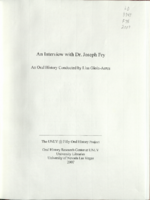
Transcript of interview with Dr. Joseph Fry by Lisa Gioia-Acres, October 09, 2007
Date
2007-10-09
Archival Collection
Description
Dr. Joseph "Andy" Fry is currently a professor of history at UNLV. He was born and grew up in West Virginia, the only child of an insurance salesman and a public school teacher. His parents met in Ronceverte, West Virginia, and lived for a while in his grandmother's boarding house. He had an idyllic childhood in this small town of 2500 people. Andy received an excellent high school education, including learning eighth grade English and 2 years of Latin from his mother. After graduation, he was interested in playing college basketball and ended up at Davis and Elkins College in east central West Virginia. Undecided on a major at first, he tried math and then chemistry, but he found his niche when he began studying the history of western civilization. During his undergraduate years, Andy met his wife-to-be, Sandra Schwitzer, and they were married in 1969 in the summer after their senior year. He was accepted at graduate school in history at the University of Virginia, so he and his bride moved to Charlottesville. After that, he worked for 2 years at Virginia Tech. In 1975, Dr. Fry was offered a job at UNLV, so he and his family packed up and moved to Las Vegas. He was welcomed to the history department by such notables as Roman "Jay" Zom, Ralph Rosky, and Tom Wright. In addition to teaching, he has had the opportunity to do research, write 4 books, and edit a series of diplomatic biographies. Andy was department chair in the mid 80s and again from 1999 to 2002. He also served for three years as executive assistant to Dr. Carol Harter (president of UNLV for 11 years), but prefers teaching over administrative work. His plans for the future are to finish a fifth book and continue teaching to at least age 66.
Text
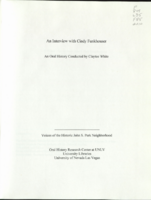
Transcript of interview with Cindy Funkhouser by Claytee D. White, January 14, 2010
Date
2010-01-14
Archival Collection
Description
Cindy Funkhouser grew up in the Midwest where she developed an early interest in "old stuff' as she refers to it. Her self-education in antiques spawned her business, Funk House, which she opened in 2001. Cindy is one of the forces behind the Downtown's arts movement and the development of First Friday, which was inspired by her observations of a similar event in Portland, OR. Cindy moved to Las Vegas around 1980. Her parents had moved to the valley in the late 1970s. When not working as a cocktail waitress at the Four Queens—a downtown casino where she was employed for 14 years—she pursued her interest in vintage items as a part-time business. Today others look to Cindy as a motivator for First Friday and the Las Vegas art movement that is deeply rooted in the John S. Park Neighborhood's sense of community.
Text
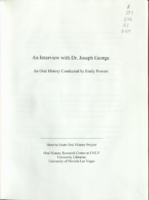
Transcript of interview with Dr. Joseph George Jr. by Emily Powers, April 8, 2008
Date
2008-04-08
Archival Collection
Description
Dr. Joseph George, Jr., was born, raised, and educated through high school in Sudlersville, Maryland. He describes his college career at the University of Pennsylvania and earning his MD degree at University of Maryland in Baltimore. There were only 15 students in his high school class and 114 in his medical class. After graduation and two years of country medical practice, Dr. George joined the Army in 1942 and became a flight surgeon. His duty assignments took him to Africa, England, and St. Petersburg, Florida, doing physical exams for pilots and flight crews and treating soldiers with mental problems. He was discharged in 1945 and headed for California, but describes his change of mind when the train arrived in Las Vegas for a brief stopover. Dr. George liked what he saw, a typical small western city, and decided to stay. He mentions the original hotels and hospitals and names many of the doctors he knew in the forties and fifties. He opened his family practice in an office on Fourth and Carson and later moved to a location on East Sahara. Over the next forty or so years he delivered more than 6,000 babies at various hospitals in Henderson and Las Vegas. Dr. George shares several anecdotes and stories, names a few notable Las Vegas patients, and comments on historical incidents that occurred here. He gives his opinions on changes he has seen in medical practice and the need for improved psychiatric care in the valley. He also talks about keeping in touch with former patients, high school classmates, and the members of his medical class at University of Baltimore.
Text
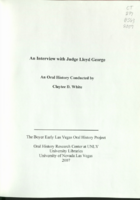
Transcript of interview with Judge Lloyd D. George by Claytee D. White, June 15, 2005
Date
2005-06-15
Archival Collection
Description
Judge Lloyd D. George was born on February 22, 1930, in Montpelier, Idaho. He attended grade school and high school in Las Vegas, Nevada, and earned his B.S. degree from Brigham Young University in 1955. Later that same year, He entered the United States Air Force and worked as a fighter pilot in the Strategic Air Command. In 1958, he concluded his military service as a captain. And in 1961, George earned his J.D. from the University of California at Berkeley. Judge George was admitted to the Nevada Bar in 1961 and began practice in Las Vegas. After 11 years in practice, he began on the path to Chief Judge: In 1974, he was appointed by the Ninth Circuit to preside over the United States Bankruptcy Court for the District of Nevada for a term of fourteen years. In 1980, Lloyd became a member of the Ninth Circuit Bankruptcy Appellate Panels and in 1984, President Ronald Reagan appointed him to the United States District Court for the District of Nevada. On July 15,1992, George was elevated to Chief Judge of the Nevada District. During his tenure on the bench, Chief Judge George held a variety of distinguished memberships. He was a board member on the Federal Judicial Center, a member of the National Bankruptcy Conference, the Chair of the Judicial Advisory for Bankruptcy Rules, the Chair of the Judicial Committee on Administration of Bankruptcy System, a Fellow at the American College of Bankruptcy, and a member of the Judicial Committee on International Judicial Relations. Judge Lloyd George is a highly respected figure in Southern Nevada and has given us a truly intriguing interview.
Text
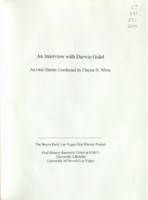
Transcript of interview with Darren Gidel by Claytee White, October 21, 2009
Date
2009-10-21
Archival Collection
Description
Darwin Gidel, born in 1924, grew up in Rockwell City, Iowa. He describes his childhood activities, schooling, and the jobs he held as a teenager. After graduating from high school in June of '42, Darwin immediately joined the military. His basic training took him from Minneapolis to Missouri, after which he was stationed in Nebraska, California, Florida, and South Carolina for further training. As he recalls his early military training, Darwin also evokes the patriotic fervor that gripped the country. He shares stories about the kindnesses he and many other enlistees received from individuals and families, ranging from rides to dinners to overnights. Darwin's overseas assignment was in London, England, beginning in November of 1943. He vividly recalls the bombing raids he flew and describes them from beginning to end. His B-l 7 was shot down over Belgium in March of 1944, and he and eight other crew members were held as POWs for eleven months. Much of Darwin's incarceration was in a Luftwaffe Hospital in Brussels, where his injured leg was removed. His memories include hospital personnel, solitary confinement, interrogation, and later being moved around to many different prisons in Germany. He clearly recalls relationships among prisoners, the configuration of German prisons, types of food served to inmates, and finally his repatriation from Annenberg Castle in Germany. After the war, Darwin earned a degree in accounting on the Gl Bill, which eventually led to general administration work in Sacramento. Along the way he married and had four children. After his wife passed away in the late seventies. Darwin eventually relocated to Las Vegas and remarried. He describes the city, recalls the small town atmosphere, and compares the impersonal bottom-line attitude of modem casinos to the folksy, welcoming feel of those establishments in the early eighties.
Text
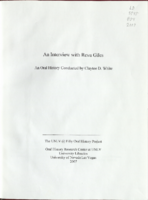
Transcript of interview with Reva Giles by Claytee D. White, July 17, 2006
Date
2006-07-17
Archival Collection
Description
Reva Giles grew up in the little town of New Carlisle, Indiana. She was one of twelve children, learning from an early age to share, to give and take, and to appreciate hand-me-downs. Her mother stayed home with the children, and her father worked for Studebaker, a large automobile manufacturer. Right after high school graduation, Reva moved to Redland, California, to live with a sister, working first at an ice cream place and then a bank. Reva married a military man, and she and their three sons followed him as he was transferred first to Las Vegas, then Okinawa, and finally Utah. When he retired in 1964, they returned to Las Vegas, where he went to work for Pete Findlay Oldsmobile. Their ' middle son Stuart played football at UNLV, and Reva got involved in fundraising and ticket sales for the team. Reva always enjoyed helping students, and from the ticket office she moved into admissions, and then student services. She worked for Drs. Ackerman and Burns helping to certify athletes, and from there went into career services, helping students find jobs and practice interview techniques. After Reva retired, Susie Smith asked her to come back and help, which Reva did gladly. She volunteers as an office aide to Susie as well as Mike Hamrick, athletic director at UNLV. Mike worked with Reva back in the eighties when he was a graduate student, and they have kept in touch through the years. Reva recalls the university campus when there were only two buildings, and was there for much of the new growth. She is familiar with the history of the Millennium Scholarship, the impact of Tarkanian's Runnin' Rebels on the community and school, and the North-South rivalry between UNLV and UNR's teams. Reva and her family have supported UNLV teams for many years, and she has many anecdotes concerning team trips.
Text
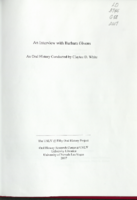
Transcript of interview with Barbara Givens by Claytee D. White, October 5, 2005
Date
2005-10-05
Archival Collection
Description
Barbara Givens was born in California, grew up in Reno, Nevada, and moved to Las Vegas in 1952 with her family when she was 14 years old. Her father ran a small construction business here in Vegas until he retired about 15 years ago. Her brother Steve and his children live in Vegas also. Barbara graduated from Las Vegas High School and enrolled in the first matriculated teacher's program at the Southern Regional Division of the University of Nevada at Las Vegas (now known as UNLV). Barbara was involved in organizing the first "Rebel Yell", school dances in Las Vegas, and other collegiate activities in Reno. In her senior year, she returned to Las Vegas High to complete her student teaching. After graduation, Barbara was assigned to Rancho High School to teach biology. She left after a year and a half because she had married and was expecting her first child. At that point in time, Clark County School District did not allow pregnant women to remain in the classroom. Fifteen years later she returned to the classroom, this time at Chaparral High. Concurrently, Barbara entered the Master's in Education program at UNLV, and graduated in 1980. Barbara has always loved to travel and has experienced many wonderful trips to exotic places around the world. In retirement, she assists with special events at Hamm Hall and Judy Bailey Theater, goes on-line to offer her services as a biology tutor to high school students, and continues to plan exciting trips abroad. She also indulges in her favorite hobby - attending Star Trek conventions and collecting Star Trek memorabilia.
Text
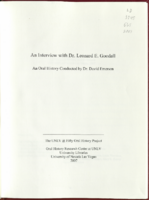
Transcript of interview with Dr. Leonard Goodall by Dr. David Emerson, March 28, 2006
Date
2006-03-28
Archival Collection
Description
Dr Leonard Goodall, former president of UNLV, comes from a unique educational background. He was born in Warrensburg, Missouri, a small town of only 6,000 souls, and received 12 years of education in the same building. After high school, he attended Central Missouri State College, which was only about 2 miles from his home. Dr. Goodall earned his master's degree at the University of Missouri, and attended the University of Illinois for his doctorate in political science. He went right into academic life, accepting a job at Arizona State in Tempe on the basis of a phone call. For five years he taught in the department of Political Science and conducted research at the institute. He subsequently moved to the University of Illinois Chicago as instructor and then chancellor (four years), and from there to the University of Michigan Dearborn as chancellor (eight years). In 1979, Leonard accepted a position as president of UNLV. He oversaw the development of the College of Engineering, helped create the UNLV Foundation, and made a number of appointments, such as athletic director, any number of deanships, and academic vice president of student affairs. After his presidency, Dr. Goodall returned to his professorship in public administration and served on many campus committees. He phased his retirement over several years, and was completely out in 2002. Today, Leonard continues to serve on graduate committees for UNLV, and works on the search committee to find a new president.
Text
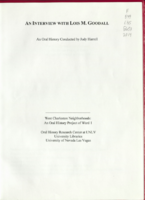
Transcript of Lois M. Goodall by Judy Harrell, November 12, 2013
Date
2013-11-12
Archival Collection
Description
Lois Goodall, wife of the fourth president of UNLV, Dr. Pat Goodall, speaks with pride when recalling her early life, marriage, and involvement with the University of Nevada, Las Vegas. She grew up in Odessa, Missouri, with a father who was a farmer and a teacher mother, went to college to become a teacher, and her freshman year met a young sophomore gentleman by the name of Pat Goodall. They married and while Pat attended graduate school at the University of Missouri, she taught fifth grade. After Pat earned his Ph.D. they moved to Arizona State University, where he taught political science, and then to the University of Illinois, the University of Michigan, and finally to UNLV. Lois, as the president's wife, enjoyed hosting various celebrities and faculty, was responsible for raising three children, and, miraculously, found time to earn her Master of Education degree in reading education and curriculum. She received her Master's hood from her husband, the president of the university, at her graduation. Expressing enthusiasm, Lois Goodall shows great delight in UNLV's growth and development. The university's Hotel Administration is second to none, and subsequent programs such as the addition of a law school imply maturity and expansion. She also admires the generosity and far sightedness of such individuals as Jerry Mack and Parry Thomas who not only funded the Thomas & Mack Center but purchased surrounding land so that the university could expand economically. Marjorie Barrick, another philanthropist, gave money for lectures benefiting faculty, students and community and also established the Barrick Scholar Award for students and Distinguished Scholar Award for faculty. As she describes the university's development, it is obvious that Lois Goodall remains one of UNLV's greatest supporters.
Text
Pagination
Refine my results
Content Type
Creator or Contributor
Subject
Archival Collection
Digital Project
Resource Type
Year
Material Type
Place
Language
Records Classification
